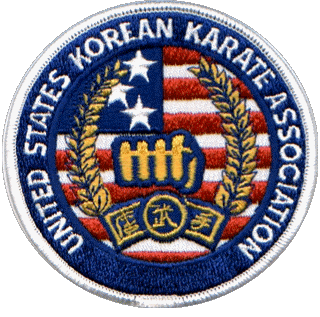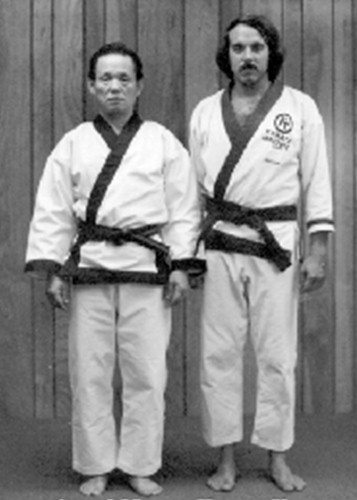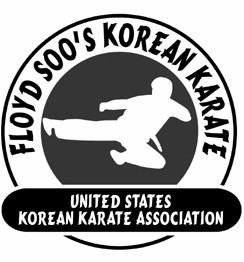 |
|||||||||||||||||||||||||||||||
|
|
|||||||||||||||||||||||||||||||
|
|
|
The Art and the Founder Grand Master Hwang Kee’s style of Tang Soo Do is a classic martial art. Its purpose is to develop every aspect of the self, in order to create a mature person who totally integrates intellect, body, emotions, and spirit. This total integration helps to form a person who is free of inner conflict and who can deal with the outside world in a mature, intelligent, forthright, and virtuous manner. "The Charter of Moo Duk Kwan charges its members to have reverence for life, and to have as a goal the preservation of life, even that of an enemy." stated Kwan Jang Nim (Grand Master) Hwang Kee. Kwan Jang Nim was born on 9 November 1914 in Jang Dan, Kyong Ki Province (where the DMZ is presently located). His parents named him "Tae Nam," which means "Star-boy" after his father saw a bright star in a dream prior to Kwan Jang Nim's birth; his name was later changed to "Kee." When Kwan Jang Nim was 7 years old, he saw a scuffle between a man and several adversaries outside of a tavern. The man was able to avoid the onslaught from his attackers and was seen counter-attacking with various kicks. Soon all the attackers were disabled by the kicking techniques used by the man. Kwan Jang Nim was so struck by this man's skill that he found out where this man lived and would watch him practice his techniques from a distance; he would then imitate all that he saw later on. Eventually, Kwan Jang Nim asked the man to teach him the techniques, but the man declined because he thought Kee was too young. What Kwan Jang Nim witnessed was "Tae Kyon," the ancient Korean art of foot fighting. This incident had an indelible effect on the young boy and thus began his lifelong devotion to martial arts. From the beginning of the Japanese occupation in 1909, Koreans were forbidden to practice any form of martial arts, except Japanese Kendo and Judo. Nonetheless, Tae Kyon survived, going underground, being secretly passed on by a few courageous and oppressed practitioners. In 1935, Hwang Kee was 21 years of age and had just graduated from High School. Shortly afterwards, he moved to China to work on the railroads in Manchuria. A year or so after he began working with the railroad company in Manchuria, he met Yang Kuk Jin, who was a Master of a Chinese martial art that some called the "Tang" method. Up until this time, Kwan Jang Nim had never had the opportunity to train with an instructor of any sort. All of his training up until this point was unstructured, informal and self-taught. He would internalize and imitate anything he saw or read on any martial art. Hwang Kee was very excited at the prospect of being able to train with a real instructor. After several discussions, Master Yang finally agreed to take him (and a friend) on as students. Kwan Jang Nim trained diligently with Master Yang until August of 1937, when he returned to Seoul, Korea. In 1939, Hwang Kee began working for the survey department of the Cho Sun Railway Bureau in Korea. The building that he worked in most of the time had a library in it. It just so happened that there were books on Okinawan karate from Japan in that library. Kwan Jang Nim studied these books closely, even though he was unable to read much of the text. It is obvious to anyone who has studied his style of Tang Soo Do that Kwan Jang Nim incorporated things that he learned from these books. The Pyung Ahn series hyungs, Bassai and Kong Sun Kung are examples of Okinawan influence in the art that Hwang Kee was to eventually introduce to the world. He certainly gave a tremendous amount of thought to these other influences and gave them his own "twist." (Master Soo is using a play on words here, as he believes that Kwan Jang Nim Hwang Kee placed great emphasis on twisting of the waist/hips and wrist/hands to generate maximum power in kicking and hand strikes. - ed.) Kwan Jang Nim discussed this subject in his book "Soo Bahk Do Deh Kahm" (1970). In 1941, Kee returned to China to train with Master Yang for a short period of time. This would be the last time that Kwan Jang Nim would be able to train with Master Yang. All communications with Master Yang would be lost after 1946 when the Communists took over China. During the time Hwang Kee was in Korea prior to Korea's liberation in August of 1945, he was unable to practice or teach any martial art. This was a challenging time in Kwan Jang Nim's life, as his dream of teaching his beloved art had yet to be realized. He did use this time to meditate, work on self-conditioning, and work out the mental aspects of his art. At this time, it can be said that Kwan Jang Nim combined three main influences for his martial art; the self taught traditional Soo Bahk that he practiced on his own, the Chinese ("Tang") martial art that he learned from Master Yang, and the Okinawan karate he studied in the Japanese books in the library at the railroad building. Realizing that all methods are only as good as those practice them, he founded the Moo Duk Kwan on 9 November 1945 (his 31st birthday), for the purpose of promoting this particular style of Tang Soo Do (Korean Karate) and establishing its philosophies and traditions. The literal translation of Moo Duk Kwan is "Institute of Martial Virtue." Since then, Moo Duk Kwan has become the most prominent style of Tang Soo Do in the world. On 25 June 1950, the Korean War began. Once again, Korean Martial Arts activity was disrupted. People were moving south to avoid the Communist invasion from the north. Hwang Kee moved south to Dae Ku, then eventually he moved to Pu San, the southernmost city on the Korean peninsula. Kwan Jang Nim taught his art for the duration of the war here. Unfortunately, some of his most senior members were lost during this period due to death or sickness. This was a sad time for Hwang Kee and he felt as though he had to start all over again. In September of 1953, the war finally ended. Hwang Kee returned to Seoul and began to teach there, despite the hardships he faced due to devastation caused by the war. In May of 1955, he leased a building in front of Seoul Central Station. This building became the legendary "Joong Ang Toe Chang" (Central Training Hall) where some of the best MDK-TSD practitioners were to come from. In addition, many of the most senior foreign MDK-TSD instructors also started here. Kwan Jang Nim persevered and despite the loss of a number of key practitioners during the war, the Moo Duk Kwan grew in size and stature. More schools were opened in other parts of South Korea, and Hwang Kee himself was becoming known even to the general public for his technical and spiritual contributions in the Moo Duk Kwan style of Tang Soo Do. The Moo Duk Kwan system was now taught in schools, police departments and even in military installations. However, following the war, American servicemen were still stationed in many bases in South Korea. The U.S. 8th Army in Yong San, Seoul, was introduced to Hwang Kee's martial art in 1957. Kwan Jang Nim was thrilled to see positive response from the U.S. military personnel, as this was his first connection to people from a foreign nation and the first step in his quest for world peace. The Japanese occupation and the Korean War had a profound effect on Hwang Kee and one of his dreams was to achieve world peace by improving human relations through the practice of his style of Tang Soo Do. It was in this post-Korean War era that U.S. servicemen like Dale Drouillard and Carlos "Chuck" Norris were trained in Moo Duk Kwan - Tang Soo Do. The rest, as they say, is history. 1957 was also additionally significant to Kwan Jang Nim, as he also discovered Soo Bahk in the Moo Ye Dobo Tong Ji ("Record Book of Military Arts") that year. He spent many long and tiresome hours of study in order to facilitate the rebirth of Soo Bahk for the martial art practitioners of the modern world. Hwang Kee realized the importance of what he had found and named it "Tang Soo Do - Soo Bahk Do" and began to promote it in 1957. The Moo Duk Kwan and the Ji Do Kwan combined efforts and formed the Korean Tang Soo Do (Soo Bahk Do) Association. This organization was incorporated in Korea and registered with the Ministry of Education on 30 June 1960. Unfortunately, political hardship for Kwan Jang Nim had not ceased. On 16 May 1961, a military revolution began in South Korea. The military government that seized power was not sympathetic to Hwang Kee. Kwan Jang Nim was relieved of his duty as instructor at the National Police Academy and ROK Air Force Academy. In addition, there was pressure on Tang Soo Do to merge with Tae Kwon Do. Agreement was never reached for this unification and the ensuing political battles deeply divided practitioners and the Moo Duk Kwan lost many key members because of it. Kwan Jang Nim had established the now famous "Dan Bon" system of numbering certificates awarded for Midnight Blue (Black) Belt using "Pin Numbers" to identify the numerical order (and thus seniority) that these certificates were issued. It was during this period of time that someone attempted to destroy these records. To add insult to injury, the Moo Duk Kwan ended up in court against the Korean government in 1965 - 66 and successfully defended against the government's attempt to dissolve Kwan Jang Nim's organization. Much of the negative politics declined in 1979, and this allowed Hwang Kee to focus more on his martial art and his quest for world peace. He actively supported his son Hwang H. C. (known as Hwang Jin Mun before his name change) who was, and still is, in charge of the "Federation" in the U.S. In fact in August 1983, Kwan Jang Nim introduced a new series of forms, known as the "Chil Sung Hyungs," he then followed that with the introduction of the "Yuk Ro Hyungs" in March of 1991. In the '80s and '90s, Kwan Jang Nim traveled extensively all over the world organizing training seminars, tournaments, clinics and organizational meetings. As the new Millennium approached, Hwang Kee was finally able to spend most of his energy traveling around the world, teaching his beloved art. Kwan Jang Nim Hwang Kee was a martial arts prodigy. His dedication to his beliefs, leadership of, and mission for world peace have affected and will continue to affect us forever. He is the ultimate example of what a martial artist is supposed to be. We learn from and follow his example, and his teachings will live on forever and will never be forgotten. He has inspired and moved us all. |
| [Home] [Master Floyd Soo] [Self Defense] [Club Information] [Art & Founder] [Tang Soo Do Info] [Current Events] [Photo Album 1] [Photo Album 2] [Photo Album 3] [Photo Album 4] [Photo Album 5] [Photo Album 6] [Photo Album 7] [Photo Album 8] [Photo Album 9] [Photo Album 10] [Photo Album 11] [Photo Album 2012] [Photo Album BB Test] [Of Interest] [Inspiration] [Testimonials] [Class Schedule] [Pontiac Class] [Goodies] [Members Only] [Contact us & Links] |


